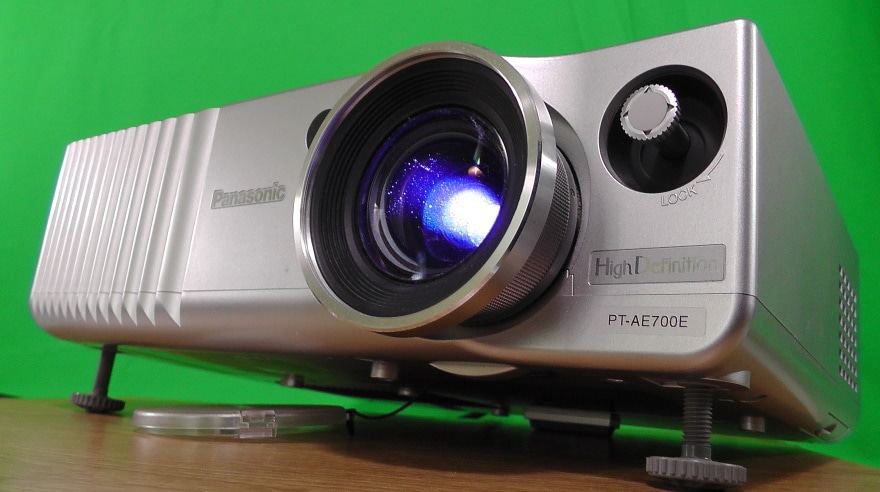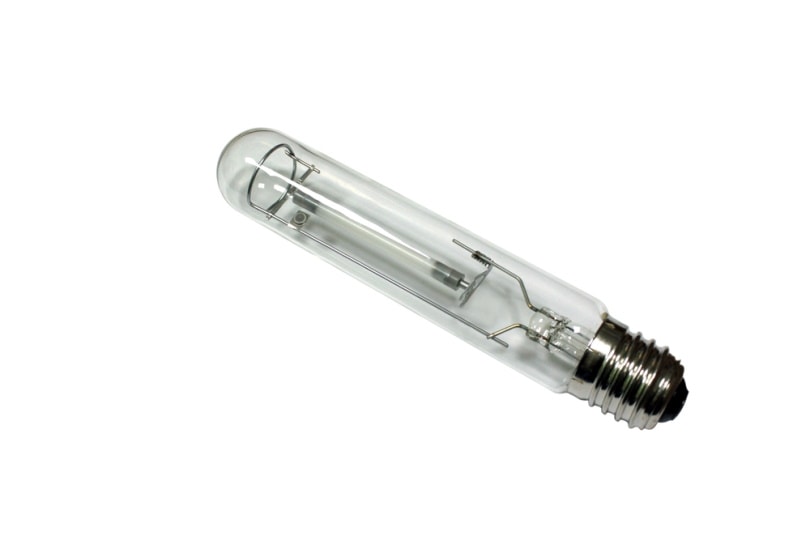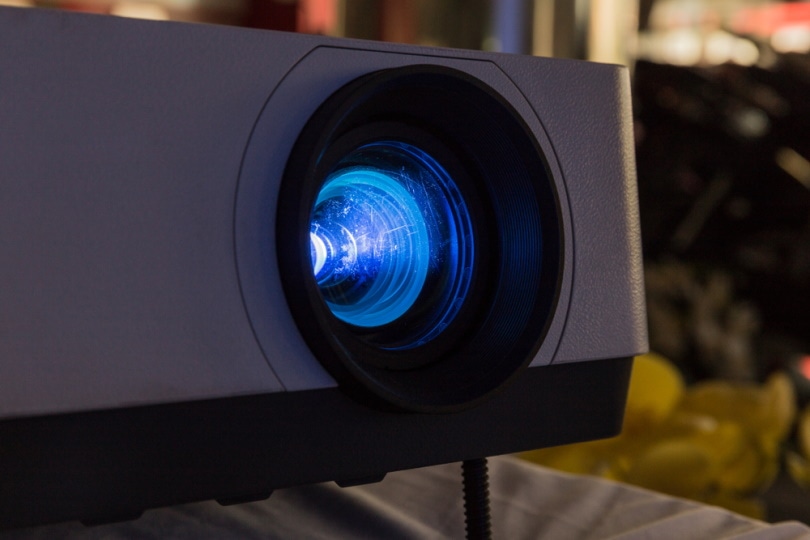How Long Do Projector Bulbs Last? What You Need To Know!
Last Updated on

In general, projector bulbs last roughly 1,500 to 5,000 hours. Under normal conditions, an ordinary bulb should last within that range.
However, technology has helped us improve a lot of things. One of those things is the new bulbs that we’re now using in projectors. There are new designs that can serve you for more than 5,000 hours, depending on the brand, usability, and maintenance.

Types of Projector Bulbs
A lot of people are quick to assume that all projector bulbs are similar. But they aren’t. And they can’t be, seeing as different projectors rely on different technology to project the different qualities of images that we see. The one thing that will determine what bulb you end up using is the type of electrical circuit it utilizes.
From our understanding, there are three types of projector bulbs. There’s Xenon, UHP Mercury, and Metal Halide.
Xenon Bulbs
These projector bulbs produce light by charging electricity through xenon. By the way, xenon is an extremely rare type of gas that’s tasteless, colorless, and almost five times heavier than air. When electricity is passed through its ionized version, a bright white light is automatically produced—a light so bright that it could easily be mistaken for natural sunlight.
You’ve likely seen or even used this type of bulb before because many automobile headlights are made of them. They are also popular in the medical field, as surgeons prefer working with compact headlamps that offer uniform brightness for longer durations.
https://www.instagram.com/p/CIVDXH3BhtG/
UHP Mercury Bulb
UHP is an acronym that stands for Ultra High Performance. But the ‘P’ initially stood for ‘Pressure,’ because it requires a certain amount of pressure to be exerted internally for it to function. This bulb is the brainchild of the Philips corporation and was developed in 1995 for commercial use. That’s why they are mostly found in theater projectors and pieces of equipment that have relatively similar functions.
How long the bulb lasts will be contingent on the projector’s cooling system and the unit it’s been installed into. They only utilize mercury and are highly efficient compared to the bulbs currently found in the market.
Metal Halide Bulbs
Metal halide is a byproduct of metal and halogen. Light is normally produced inside the bulb when its electric arc passes through a gaseous mix. The gasses found in the bulb include argon, xenon, and mercury.
These bulbs have higher luminous efficacy, and also produce light that looks more natural. However, unlike the bulbs that we’ve just discussed, they offer a wide variety of color temperatures.
Sadly, they require a warm-up period to start emitting light, or project at their highest output. But that hasn’t stopped consumers from installing them as stage lights, security lights, factory lights, or car headlights.

Extending The Life Of a Projector Bulb
Maintenance is important if you want your bulb to serve you for the whole period of its rated lifespan. Once that time elapses, you can then worry about getting the most out of it. Let’s look at some of the things you can do, while operating, storing, or moving the projector.
Energy saver/ Economy mode
You’ve likely seen or used this feature while operating your smartphone. It’s meant to help your device operate efficiently, without using too much energy. The same applies to certain brands of projectors—not all of them, as some don’t have it.
The “economy mode” will decrease the brightness of your bulb, to reduce the likelihood of it overheating. If you have no clue as to how you’re supposed to enable it, reach for the manual. Ideally, the economy mode settings should be in the menu, or system settings.

Storing
Projectors don’t do well in extreme temperatures. Don’t try to project images outside during winter or move the projector around in a car on a hot summer afternoon. Treat this device with the utmost care for the best results.
Don’t operate it in a crowded space
Your projector will need room to breathe. The fan inside is meant to regulate its internal temperature, and that will be difficult if there’s no space to allow excess heat to dissipate. Overheating will result in a thermal shutdown, a sign that the system was overstrained.
Clean your projector
Every electronic device needs to be cleaned regularly, and a projector is no different. So, once you’re done cleaning it, clean the space around it.
Be careful not to just clean the device and ignore its environment. That dust and tiny particles will be sucked in by the fan, everything including the air filters will get clogged up, and the device may overheat.

Cooling down
Your projector should be given at least 10 minutes to cool down once it’s been switched off. During that short period, you’re not allowed to move it. Hot lamps are more delicate than cooler lamps, thereby making them more susceptible to damage.
Do not overuse your projector
A good model can operate for 5 to 10 hours, but not 24/7. Even if you’re using it to watch a series marathon, no marathon should go on for 24 hours, 7 days a week. That would cause the temperature to rise, and ultimately, damage all of its components.

Frequently Asked Questions
What’s the cost of replacing a projector bulb?
The cost will be dependent on a couple of factors. You’ll have to take into consideration the size of the device you’re using, compatibility, brightness effect, light spreaders, and more importantly, the cost of installation.
The installation cost is the big one because whoever you hire will also take into consideration the type of internal damage, cost of tools needed, type of bulb being installed, and the time invested. So even if the projector bulb that you need only costs $50, the cost of replacement might be more than $400.

What are the signs you need a new projector bulb?
The most common sign is the popping sound that you’ll keep on hearing anytime you try to switch it on. The screen will then go dark, and nothing will happen from there on out. You can try switching it off and on, but nothing will change.
If you’re using a high-tech projector, there will be an indicator light or message. It’s one of the features incorporated in the design to let users know when the bulb needs to be changed. The light will only come on when the bulb is malfunctioning.
A flickering image and a shift in color change is also a sign. OEM projectors usually display colors that are not only clear but also crisp. So if you notice the colors are starting to look sort of muddy, that’s all the sign you need. A flicker, on the other hand, could be a sign that your bulb is about to fail.
Do projector bulbs burn out?
They do, but not before they get to the end of their lives. And you’ll know when your bulb is about to burn out because they always start to get dimmer, produce substandard images, or put out less light. Basically, if you sense that the performance rate has gone down, you should start budgeting for a new bulb. The good news is, that if it’s a quality bulb, it should never fail prematurely.

Why are projector bulbs so costly?
The technology used to make some of these bulbs is the reason why some of them are costly. While for others, it’s the material. A good example is the high-pressure mercury bulb. The toxicity of mercury and the intricate nature of the production process are the two reasons why the bulb is so expensive.
Is upgrading a projector bulb an option?
A halogen or UHP bulb can be replaced with an LED bulb. Unfortunately, it won’t be an easy task. You see, the technology that comes with LEDs is very different from that used with a projector bulb. You’ll probably have to also replace the transformer, heat sink, and motherboard.

Conclusion
You should take good care of your projector if you want its bulb to serve you for its rated lifespan. Replacing one is not as simple or as easy as replacing one of the bulbs in the house. They usually demand a lot of time and money, which are resources that are always limited.
Featured Image Credit: Piqsels
About the Author Robert Sparks
Robert’s obsession with all things optical started early in life, when his optician father would bring home prototypes for Robert to play with. Nowadays, Robert is dedicated to helping others find the right optics for their needs. His hobbies include astronomy, astrophysics, and model building. Originally from Newark, NJ, he resides in Santa Fe, New Mexico, where the nighttime skies are filled with glittering stars.
Related Articles:
How to Collimate Binoculars: 9 Expert Tips
How to Clean a Refractor Telescope: Step-by-Step Guide
How to Clean a Telescope Eyepiece: Step-by-Step Guide
How to Clean a Rifle Scope: 8 Expert Tips
Can You Use Binoculars to Look At Stars? How to Choose the Right Pair
How to Choose Binoculars for Bird Watching: 10 Expert Tips
Monocular vs Telescope: Differences Explained (With Pictures)
What Is a Monocular Used For? 8 Common Functions
